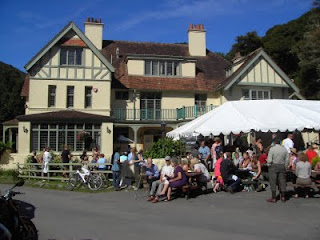
Have been reading the various posts and comments on brewing innovation (or lack of thereof) with great interest, but it wasn’t until going to a
Fuller’s tasting conducted by head brewer John Keeling that the thoughts that have been swirling around in my head started to form themselves into a coherent mass. In over ten years of beer writing I have blithely chucked around the word ‘innovatory’ when discussing the likes of barrel-aging beers, blended beers or
extreme beers, but Keeling helped to concentrate the mind and crystallize my thoughts — and this incomplete post (can anything ever be complete?) on what I see as the collective amnesia that spread through the brewing industry in the 20th century is the result.
The event at Fuller’s last week was a celebration of their
Fine Ale Club which was set up 10 years ago. In front of about 40/50 people Keeling inspired and enthralled as he led the assembled through a taste of various Fuller’s beers. If you’ve ever had a beer palate that sometimes screams ‘give me a break!’, as I sometimes do, then this jovial dry-witted Manc is the man to perk things up, to deliver another perspective on beer. A revelation for me was the Brewer’s Reserve, something that I hadn’t tasted before, though I’d tried the various prototypes several years ago at the
British Guild of Beer Writers’ seminar on wood-aged beer. The result is a superb beer, a soothing and warming beer with butterscotch and vanilla notes, as well as a whisper of whisky (nothing too fiery), plus a great orange marmalade character; having almost starting to become jaded with British brewers’ wood-aged beers (apart from BrewDog’s Springbank, one of the best beers I have tasted in the past 12 months), Brewer’s Reserve provided a welcome surprise.
Another thrilling aspect to Keeling is his willingness to experiment; London Pride may be his bread and butter but he’s eager to produce beers that a brewery of Fuller’s size would have in the recent past turned their noses up at (there are still some medium sized breweries, which started out as micros and are now small regionals, that look askew when you ask them if they like to up the hop rate or wood age their strongest ale). I remember when Fuller’s bought Gale’s and I asked Keeling if their
Prize Old Ale would survive. He wasn’t sure, but perseverance and his open-minded attitude have led this beer to thrive and prosper. The 2007 vintage was brewed at
Gale’s and matured at Fuller’s; now Keeling is blending fresh and stale beer together: there is still an amount of the original Prize Old Ale sitting in tank and each time a vintage is made the beer will consist of 35% of the original beer blended with a fresh version (ghost beer?). Innovation or just an example of brewers starting to remember what they used to do?
‘We are rediscovering the past,’ he said as he talked on another subject, the revival of amber malt in the 1990s by his predecessor Reg Drury (present in the audience) for 1845. ‘There wasn’t any available so we had to ask our maltsters to produce some.’ Interestingly enough Keeling spoke of how he and Drury discovered that as 1845 got older the more it improved. ‘This was a catalyst for us thinking about aging beers.’
For a while brewers forgot what they used to do, they lost the art of aging beer, they dismissed from their minds memories of how they used to blend old and new, how to let the right microbes in, keep the wrong ones out; they forgot that fruit, herbs and spices could be an integral part of the beer they brew; they forgot that beers could be strong or weak, could be left to ripen, to grow old and elegant, ready to be embraced and engaged by a younger generation of beer. Stock ales, running ales, porters, stout porters, stouts, all beat the drum for progress in the past — the last 20 years has seen the fog of forgetfulness lift and a rediscovery of and improvement on the past emerge. Barrel-aging might be old but to return to the theme of innovation, what is innovatory is the thinking of people like Keeling, BrewDog, Tomme Arthur, Roger Ryman, Vinnie Cilurzo, Mikkel Borg Bjergsø and even Jean-Pierre Van Roy in either sticking with the past or finding new ways of interpreting it. Let us make sure this is never lost again.
(Pic shows Fuller’s at night — on a par with Paris at night I reckon)





































